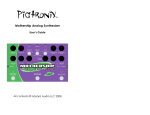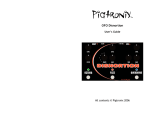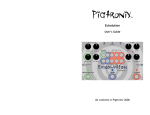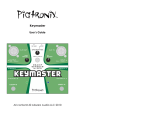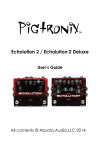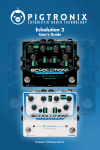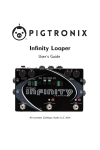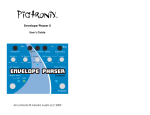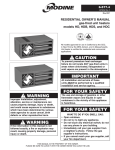Download Absara Audio Philosopher King User`s guide
Transcript
Pigtronix tm Philosopher King User’s Guide All contents © Absara Audio LLC 2010 Index: Welcome……………………………………………………..… Anatomy of the Philosopher King….……………….……… Getting Started…..……..….………………………………….. Guided Tour…………..………………………………………… Notes………..……….…………………………………………… Limited Warranty….……………………………………….…… Safety Precautions………….…………..………………….….. Welcome! Thank you for entering the realm of Pigtronix. Your Philosopher King pedal is a compressor, distortion and envelope generator. Big brother to the Philosopher’s Tone and descendant of our Attack Sustain pedal, the Philosopher King was designed to give your guitar a HUGE sound and then change the shape of that sound’s amplitude over time. In other words, this is an ADSR for guitar coupled to an incredible sustainer. The compression section of the Philosopher King can be set for transparent, ultra-clean optical limiting or it can unleash relentless sustain and howling distortion as you turn the knobs clockwise. The compressor output is then fed into an amplitude modulation section that can morph a standard plucked note into a volume swell, stuttering tremolo or even a psychedelic backwards tape emulation. With the SWELL and FADE footswitches turned off, the Philosopher King operates as a Compressor / Sustainer / Distortion only. The amplitude modulation is introduced by turning on the SWELL and FADE footswitches and can be manipulated by external expression pedals or CV input. The Philosopher King will accept instrument or line level signals, making it a suitable effect for any electronic source. In keeping with Pigtronix tradition, the controls on the Philosopher King have been tuned to provide the fattest possible tone and the widest range of musical possibilities. The Philosopher King was born out of a passion for versatile, expressive musical effects; it is built to last and designed to inspire. We hope that the Philosopher King will provide you with years of creative satisfaction. Pigtronix Anatomy of the Philosopher King: The Interface: Jacks: 1. IN – Plug in your instrument here. 2. TRIGGER – This is a side-chain input for the envelope detector within the Philosopher King. The trigger feature allows you to connect an external source to control the timing of the SWELL and/or FADE cycle. 3. OUTPUT – Effect output – Plug in your amp, mixer, DI box, etc. here. 4. DC POWER 18-VOLTS – Use only the 18-Volt, 300mA, negative tip power supply that came with your Pigtronix Philosopher King. Using the wrong power supply could result in a damaged pedal. 5. CV in – Insert CV control signal or a TRS expression pedal for remote control of the amplitude modulation. 6. CV out – The internal control voltage that sets the amplitude at any given moment is available from this jack. The range is approx. 2VDC 12VDC. 7. SWELL EXP – Insert a high impedance (250K - 500K) expression pedal here to control the SWELL TIME. 8. FADE EXP - Insert a high impedance (250K - 500K) expression pedal here to control the FADE TIME Footswitches: 9. SWELL – This footswitch turns the SWELL function on and off. When the SWELL feature is in use, notes will have a slow attack, becoming louder at the rate set by the SWELL dial. 10. ENGAGE – This footswitch turns the entire effect on and off. When only the Engage light is turned on, the pedal acts as a compressor / sustainer / distortion. When the engage light is turned off, the Philosopher King is bypassed. 11. FADE – This footswitch turns the FADE function on and off. When the FADE feature is in use, notes will become quieter at a rate set by the FADE dial. Compressor Controls: 12. VOLUME – This dial sets the master output volume of the pedal when engaged. 13. COMPRESSION – This dial determines the balance of clean and compressed / distorted signal. When turned fully counter-clockwise, you will hear only the pure input signal. When turned fully clockwise you will hear only the effect signal. note: The SWELL and FADE functions will modulate the un-compressed, clean signal if the COMPRESSION knob is set counter-clockwise. 14. GRIT – This dial mixes a layer of grinding distortion into the effect sound. 15. SUSTAIN – This dial sets the threshold of the compressor, increasing sustain as this knob is turned clockwise. 16. TREBLE – This dial provides 2Khz boost or cut. Envelope Generator Controls: 17. SWELL – This dial determines the duration of time it takes for a note to swell in from silent to full volume. 18. FADE – This dial determines the duration of time it takes for a note to fade out from full volume to silent. 19. HOLD – This dial mixes the post-compressor audio with the modulated audio. When HOLD is counter clockwise, the FADE cycle will bring the output all the way down to infinite attenuation. As you turn the HOLD knob clockwise, the audio will lose less volume during the fade cycle. Use the HOLD knob to blend pure compression signal into the mix. 20. RELEASE – This LED tells the musician when the pedal is armed and ready to begin the SWELL and/or FADE cycle. When a note is played, the Release light will turn off and the SWELL and/or FADE cycle will begin. 21. SENSITIVITY – This dial determines how much input signal is needed to reset the SWELL and/or FADE cycle. Use this knob to set the cutoff point below which the pedal needs additional signal to re-trigger the cycle. Leave the SENSITIVITY dial clockwise most of the time. Toggles: 22. ONE SHOT – When it is on, the ONE SHOT switch causes the SWELL and/or FADE functions to ignore any input from instrument once the cycle starts. This allows you to play whatever you want, without retriggering the modulation cycle. When ONE SHOT is off, swell and fade cycle can be interrupted at any point, by muting your instrument. 23. SPEED RANGE – The SLOW setting gives you a wider range of available SWELL and FADE times. The FAST mode gives you fine tune control of the shorter SWELL and FADE times. 24. AUTO RESET - The auto-reset feature allows for a wide range of variable tremolo effects. If there is any input signal present when the end of the FADE cycle, auto reset causes the modulation cycle to begin again. When AUTO RESET is off, you must mute your instrument to set the cycle up for re-trigger. Leave AUTO RESET on most of the time. Getting Started: Basic Hook Up 1. Unpack your Philosopher King and place it on a flat, stable surface. 2. Make sure you are using the 18-Volt DC (negative center) power supply that came with your Pigtronix Philosopher King. 3. Plug the power cord into the 18VDC jack on the back of the Philosopher King and then plug the power adaptor into an electrical socket. The Philosopher King is now powered up. To turn the device off, unplug it from the wall or turn off the power going to the socket that the power supply is plugged into. We recommend that you do not leave your Philosopher King powered up for long periods of time when it is not in use. 4. Plug your instrument into the “IN” jack and plug your Amplifier into the “OUT” jack. Guided Tour: The following steps guide you through the sonic palette of Philosopher King and show you how to get at the range of tones that it has to offer. Compression Controls 1. Set all of the controls fully counter-clockwise and set the toggles to the right. The Release light should be lit, but the other LEDs should be off. The Philosopher King is in bypass mode. Play your instrument and make sure a clean sound is passing through the pedal. 2. Turn up the SENSITIVITY to 3:00. 3. Turn the Volume control up to 12:00. Click the Engage footswitch to turn the Philosopher King on. Play your instrument. You should hear the same sound as in bypass. Turn the COMPRESSION control up all the way and play your instrument. You will now hear the compressor/sustain effect. 4. Turn up the SUSTAIN 5. Turn up the GRIT 6. Turn up the TREBLE SWELL and FADE 7. Turn on the ATTACK footswitch and bring the ATTACK dial up to 12:00. Play a chord and notice how it swells in from silence up to full volume. Note: Once the attack cycle has been triggered, the musician must mute their instrument in order to reset the attack cycle. When the instrument is muted, the RELEASE light comes on, letting the musician know that the SWELL function is armed. The touch sensitive nature of the SWELL function lets the player control the threshold between the volume swell effect and a pure compression sound with playing dynamics and muting technique. Note: Lower SENSITIVITY settings will require less muting, however the SWELL function can reset prematurely if the SENSITIVITY is set too low. 8. Explore the range of the SWELL control and then turn off the SWELL footswitch. 9. Turn on the DECAY footswitch and bring the DECAY dial up to 12:00. Play a chord and notice how it fades out from full volume to silence. Explore the range of the DECAY control. 10. Turn up the HOLD to 12:00, notice how the decay does not go fully to silent now. Explore the range of the HOLD control. The Decay function in this pedal is equipped with an automatic reset feature that re-arms the pedal each time the decay cycle is finished. Be sure to check out the shortest Decay settings for square wave tremolo and rapid stutter sounds. 11. Turn on the ATTACK footswitch. Now all three footswitch lights should be lit up. Start off with both the ATTACK and DECAY dials set at 9:00 and then change them one at a time to create different tremolo shapes. 12. Turn off the Auto Reset and notice how you must mute to retrigger the modulation cycle at the end of the FADE. 13. Set SWELL to 11:00 and the FADE to 8:00. This medium-long attack and fast decay setting provides a tape reverse emulation for plucked string instruments. 14. Turn on the ONE SHOT and choose long SWELL and FADE settings. Notice how you can mute while the cycle is going and without resetting Notes: LIVE PERFORMANCE - The Philosopher King provides four preset sounds on stage depending which footswitches are selected: 1 – Sustainer = ENGAGE only 2 – Volume Swell = ENGAGE and SWELL 3 – Stutter = ENGAGE and FADE 4 – Tape Reverse / Tremolo = ENGAGE and SWELL and FADE SIGNAL FLOW – For optimum performance, place the Philosopher King after your synth and pitch tracking pedals, but before distortion, modulation and delay pedals. SIDECHAIN – The trigger jack can be useful for creating interactive effects between members of band where the signal from one musician triggers the swell and fade cycle of another musician’s Philosopher King. FOR SAMPLE SETTINGS, please visit the Philosopher King product page on our website: www.pigtronix.com Limited Warranty: Your Pigtronix effect pedal comes with a 1 year limited warranty on parts and workmanship. During the warranty period we will repair or replace, at our option, defective parts or pedals free of charge, and return them to the owner. Warranty service does not include damaged, modified, or misused pedals and such pedals will be subject to a standard repair charge. Contact us directly via email and describe the problem to us. If the problem cannot be resolved we will have you send your pedal directly to us for servicing. How to contact us for warranty service: Email: [email protected] Warranty Limitations: This warranty does not cover defects resulting from improper or unreasonable use, accident, unauthorized tampering or modifications; and, warranty shall be considered void if Philosopher King chassis has been opened. Please consult the instructions and warnings in this manual for proper use. Warranty is only valid if your Philosopher King has been properly registered within 30 days of original purchase date, and upon warranty registration, will be valid for 12 months from original purchase. To validate your 1-year, limited warranty, please register your PHILOSOPHER KING, within 30 days of purchase, on the web at: www.pigtronix.com/warranty Safety Precautions: Please be sure to observe these precautions. The safety precautions listed below are intended to ensure your safety whenever you use the equipment. NEVER OPEN THE CASE – Never try to separate the two pieces of the chassis from one another and/or modify the equipment. Opening this device will effectively void the warranty. STOP USE IN CASE OF PROBLEM – Stop using the equipment if ever you should notice smoke or a strange odor coming from it. Contact your original dealer or nearest authorized service provider for service. AVOID HIGH TEMPERATURES & HEAT BUILD UP – Never cover the power supply with cloth or other objects. Built up heat creates a danger of equipment deformation and fire. Do not expose the Philosopher King to direct sunlight, heating devices, or other extreme temperatures. USE SPECIFIED POWER ADAPTOR ONLY – Be sure to use only the 18-Volt DC 300mA Adapter that came with your Pigtronix Philosopher King and is specified in this user’s guide. DO NOT EXPOSE TO WATER/BEER – To reduce the risk of fire or electric shock, do not expose your Philosopher King to rain or moisture. If water gets inside the unit, turn off the power supply and consult your dealer or nearest authorized service provider. Final Notes Years of work have gone into making the Philosopher King Pedal possible. We would like to thank the following people for their help along the way: Howard Davis, Lisa Rickmers, the Bethke and Koltai families, Craig Brodhead, Matt Smith, Soulive, Aaron Reed, Dan Pavone, Kevin Tobler, Fitz and B-Dawg. Howard “Mick” Davis and David Koltai designed the Pigtronix Philosopher King during 2009 in Brooklyn, Yonkers and Port Jefferson, NY. We hope you enjoy your new Philosopher King pedal! Please check our website, www.pigtronix.com or contact us at (917) 941-2861 for the latest information on new Pigtronix gear. Dave Koltai & Brian Bethke Pigtronix










